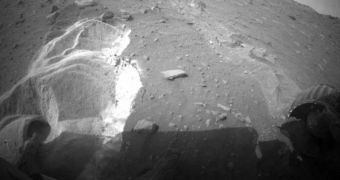The Spirit rover is currently in a “sticky” situation, so to speak, having been trapped inside a very soft area of soil on the Red Planet since May 7th. After several attempts to get the robot to move in any direction, Mars Exploration Rovers (MER) mission controllers decided to temporarily halt all driving with the tiny platform, and moved on to conduct tens of simulations of its condition, using an identical robot at the Jet Propulsion Laboratory (JPL), in Pasadena, California. On May 16th, a diagnostics test revealed that electrical resistance in the left middle wheel indicated that the motor driving it had not yet failed.
“Spirit is in a very difficult situation. We are proceeding methodically and cautiously. It may be weeks before we try moving Spirit again. Meanwhile, we are using Spirit’s scientific instruments to learn more about the physical properties of the soil that is giving us trouble. The improved power situation buys us time. We will use that time to plan the next steps carefully. We know that dust storms could return at any time, although the skies are currently clear,” JPL expert John Callas, the project manager for the MER mission, said when the rover first became stuck.
The new diagnostics test is “not a full exoneration of the wheel, but it is encouraging. We’re taking incremental steps. Next, we’ll command that wheel to rotate a degree or two. The other wheels will be kept motionless, so this is not expected to alter the position of the vehicle,” Callas added recently. Since the iconic rover got stuck in the ground, everyone has rushed in to help save the resilient machine, which has been roaming the Martian surface for the past five years.
The Mars Odyssey team has also allowed the orbiter to pick up extra transmissions from Spirit, and to relay them to the JPL, for analysis. Because strong winds cleaned the rover's solar panels four times in the last month, the instrument has now sufficient energy to send not one, but two transmissions each day. The experts are using this to their advantage, and are having all the robot's cameras snap pictures of its surrounding area. They have even involved Opportunity in the rescue efforts, despite the fact that Spirit's twin robot is located on the other side of the planet.
Opportunity, which is in considerably better shape than Spirit, is currently using its robotic arm to move its mounted camera in a position from which to observe if the belly of the rover is touching the Martian surface. NASA experts hope to use the same procedure on the other rover as well, to see if the underbelly of the robot is touching the loose Martian soil. Once sufficient data are collected, engineers will set up driving simulations at JPL, and will attempt to mimic the best course of action for Spirit. However, experts say weeks may pass before any move is attempted.

 14 DAY TRIAL //
14 DAY TRIAL //